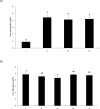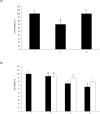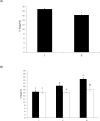Wheat phytase can alleviate the cellular toxic and inflammatory effects of lipopolysaccharide
- PMID: 33987589
- PMCID: PMC7882845
- DOI: 10.5187/jast.2021.e12
Wheat phytase can alleviate the cellular toxic and inflammatory effects of lipopolysaccharide
Abstract
The objective of this study was to characterize the enzymatic hydrolysis of lipopolysaccharide (LPS) by wheat phytase and to investigate the effects of wheat phytase-treated LPS on in vitro toxicity, cell viability and release of a pro-inflammatory cytokine, interleukin (IL)-8 by target cells compared with the intact LPS. The phosphatase activity of wheat phytase towards LPS was investigated in the presence or absence of inhibitors such as L-phenylalanine and L-homoarginine. In vitro toxicity of LPS hydrolyzed with wheat phytase in comparison to intact LPS was assessed. Cell viability in human aortic endothelial (HAE) cells exposed to LPS treated with wheat phytase in comparison to intact LPS was measured. The release of IL-8 in human intestinal epithelial cell line, HT-29 cells applied to LPS treated with wheat phytase in comparison to intact LPS was assayed. Wheat phytase hydrolyzed LPS, resulting in a significant release of inorganic phosphate for 1 h (p < 0.05). Furthermore, the degradation of LPS by wheat phytase was nearly unaffected by the addition of L-phenylalanine, the inhibitor of tissue-specific alkaline phosphatase or L-homoarginine, the inhibitor of tissue-non-specific alkaline phosphatase. Wheat phytase effectively reduced the in vitro toxicity of LPS, resulting in a retention of 63% and 54% of its initial toxicity after 1-3 h of the enzyme reaction, respectively (p < 0.05). Intact LPS decreased the cell viability of HAE cells. However, LPS dephosphorylated by wheat phytase counteracted the inhibitory effect on cell viability. LPS treated with wheat phytase decreased IL-8 secretion from intestinal epithelial cell line, HT-29 cell to 14% (p < 0.05) when compared with intact LPS. In conclusion, wheat phytase is a potential therapeutic candidate and prophylactic agent for control of infections induced by pathogenic Gram-negative bacteria and associated LPS-mediated inflammatory diseases in animal husbandry.
Keywords: Inflammatory diseases; Lipopolysaccharide; Prophylactic agent; Therapeutic candidate; Wheat phytase.
© Copyright 2021 Korean Society of Animal Science and Technology.
Conflict of interest statement
No potential conflict of interest relevant to this article was reported.
Figures





Similar articles
-
Wheat phytase potentially protects HT-29 cells from inflammatory nucleotides-induced cytotoxicity.Anim Biosci. 2023 Oct;36(10):1604-1611. doi: 10.5713/ab.23.0031. Epub 2023 Jun 26. Anim Biosci. 2023. PMID: 37402454 Free PMC article.
-
Effect of long-chain inorganic polyphosphate treated with wheat phytase on interleukin 8 signaling in HT-29 cells.Anim Biosci. 2022 Jun;35(6):892-901. doi: 10.5713/ab.21.0436. Epub 2022 Jan 5. Anim Biosci. 2022. PMID: 34991200 Free PMC article.
-
Potential immune-modulatory effects of wheat phytase on the performance of a mouse macrophage cell line, Raw 264.7, exposed to long-chain inorganic polyphosphate.Anim Biosci. 2021 Mar;34(3):463-470. doi: 10.5713/ajas.20.0060. Epub 2020 May 12. Anim Biosci. 2021. PMID: 32777888 Free PMC article.
-
Catalytic properties of wheat phytase that favorably degrades long-chain inorganic polyphosphate.Asian-Australas J Anim Sci. 2020 Jan 1;33(1):127-131. doi: 10.5713/ajas.19.0047. Epub 2019 May 27. Asian-Australas J Anim Sci. 2020. PMID: 31208182 Free PMC article.
-
Development, validation and implementation of an in vitro model for the study of metabolic and immune function in normal and inflamed human colonic epithelium.Dan Med J. 2015 Jan;62(1):B4973. Dan Med J. 2015. PMID: 25557335 Review.
Cited by
-
Wheat phytase potentially protects HT-29 cells from inflammatory nucleotides-induced cytotoxicity.Anim Biosci. 2023 Oct;36(10):1604-1611. doi: 10.5713/ab.23.0031. Epub 2023 Jun 26. Anim Biosci. 2023. PMID: 37402454 Free PMC article.
-
Prediction of calcium and phosphorus requirements for pigs in different bodyweight ranges using a meta-analysis.J Anim Sci Technol. 2021 Jul;63(4):827-840. doi: 10.5187/jast.2021.e70. Epub 2021 Jul 31. J Anim Sci Technol. 2021. PMID: 34447959 Free PMC article.
References
-
- van Gucht S, van Reeth K, Pensaert M. Interaction between porcine reproductive-respiratory syndrome virus and bacterial endotoxin in the lungs of pigs: potentiation of cytokine production and respiratory disease. J Clin Microbiol. 2003;41:960–6. doi: 10.1128/JCM.41.3.960-966.2003. - DOI - PMC - PubMed
-
- Rauber RH, Perlin VJ, Fin CD, Mallmann AL, Miranda DP, Giacomini LZ, et al. Interference of Salmonella typhimurium lipopolysaccharide on performance and biological parameters of broiler chickens. Brazilian J Poultry Sci. 2014;16:77–81. doi: 10.1590/S1516-635X2014000100011. - DOI
LinkOut - more resources
Full Text Sources
Other Literature Sources

